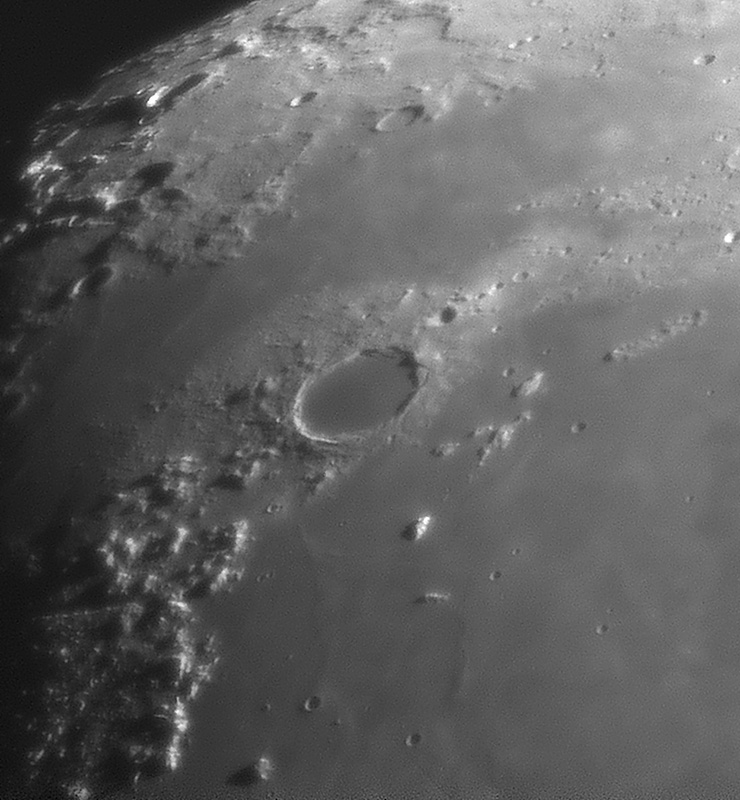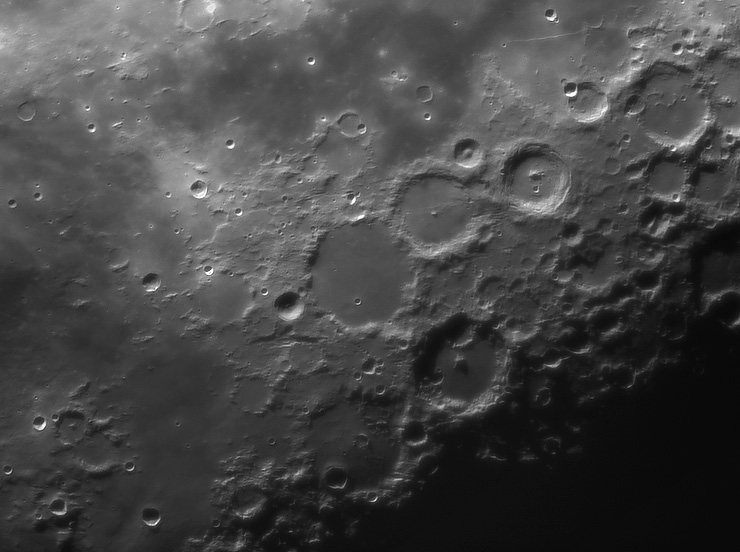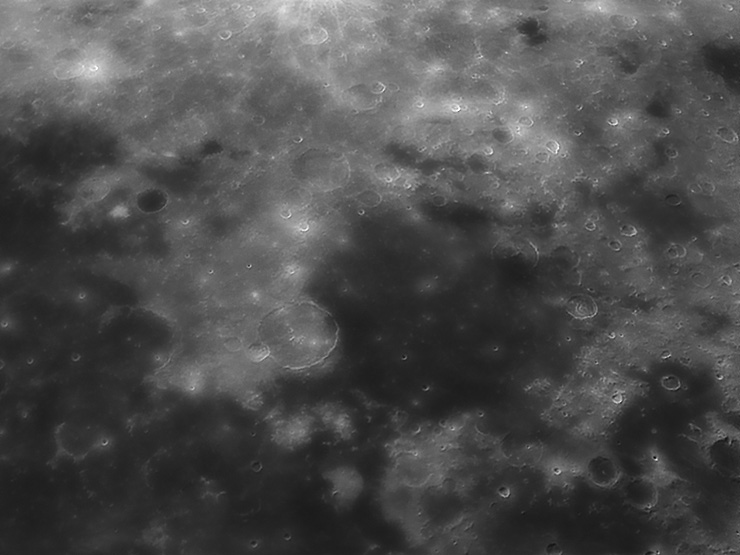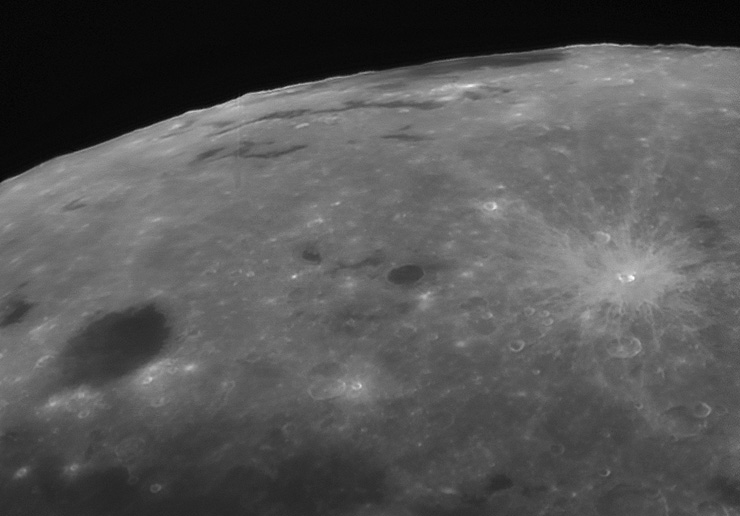Howling at the Moon, 1 :: home :: |
|
8/31/2010: As the Sun rose, I put the A-P refractor on its mount and took aim at the fading Moon. Ah, this is going to be fun. I see a new spin-off to The Slow Blog looming. First came "Staring at the Sun," and now: "Howling at the Moon."
Look at those craterlets in Clavius! Look at those terraces in Tycho! Just look at that. Not bad for a shot in bright twilight, eh? I used the same set up as for Eps Lyr and Jupiter (p20 of Staring at the Sun): A-P 5-inch with a TeleVue 2-inch Barlow. I tried several settings with the Point Grey Research Chameleon monochrome camera. This one is 200 frames of 8-bit data, auto-everything, 15 fps, about 20ms per frame. I also tried higher gain and shorter exposures of other areas, but noise can be a problem. A 12-bit AVI of this area shows little or no advantage (at least given my undeveloped lunar processing skills). I used Registax to do a multi-point alignment on the best 30% of frames, wavelets, then in PhotoShop did unsharp masking followed by Focus Magic and curves adjustments. While I was taking data, the tops of the pines lit up gold. A quarter million miles beyond them, it's sunset on the Moon.
Ptolemaeus, Alphonsus, and Arzachel: one of the great
chains of lunar craters leading from the center of the frame toward upper right.
Beyond that, the Straight Wall near the edge of the frame at upper right. This
and the previous image suffer a bit for having been reduced for the web; a
full-resolution crop would show several additional craterlets inside flat floored
Plato
and Ptolemaeus. The largest craterlet inside Ptolemaeus (Ammonius) is about 9
km across; the smaller one to its upper left (D) is 4 km. This software continually reminds me that I do not have the
proper video card, and it runs slower and slower from the moment it is launched
until it effectively seizes up some minutes later. Keep looking for better
moonware. [I located and loaded the Clementine high-res add-on for the ever-reliable
Guide from Bill Gray and Project Pluto. This is more like it.]
There's a lot to learn about optimizing images from the PGR Chameleon, and it's going to be tough if I have to do that only at the small end of telescopes. I found a Nikon to C-mount converter on eBay for a terrific price and will use that to work with the camera under controlled conditions. Eventually, it will also let me put the camera behind the fast 200mm Nikkor and other lenses. We'll see what, if anything, comes of that. While on the subject of things enroute... Damian Peach has put out a DVD on webcam astrophotography. Damian's a master of planetary imaging using comparatively modest optics. Some of the best work I've seen by Damian was done with a 9.25-inch Celestron SCT (which can be found routinely on AstroMart for under $900) and with a C14. This is refreshing considering the number of deep-sky photographers whose kits consist of five-digit OTA's. Damian's DVD was produced by Robin Scagell. So I had a couple of reasons to buy it. It's on its way from the UK. [Amy says that if we ever have a goat, she will name it, "Damian Peach." "Wouldn't that be a happenin' name for a goat?" she asks. It would.] A tome devoted to the same subject, the Lunar and Planetary Webcam User's Guide, is excerpted on Google Books. The excerpt was crystal clear and very helpful. It's on its way from the "Friends of George Masion Regional Library" (and tonight I found it in PDF form, free to download on the net [sigh]). I'm giving some thought to setting up a portable imaging desk to consolidate all the imaging parts & pieces. This thought began with the pocket drive. It would include a 17-inch LCD screen mounted in the back of something very like the Tupperware box, with room up front for the netbook, a mouse, the A-P handset, the LVI Smartguider. It would need to be powered when the LCD is in use, so there could also be a powered USB hub. That would permit me to run the SBIG camera as well. I'm determined to think this through before cutting wood or spending dollars on it. Does it need a red light? A curtain for daytime use (or a portal for peeking in and a sort of loose-fitted glove box)? Just keep the idea in mind when noting what nettles during ad hoc imaging sessions. That big white ATA case I bought years ago to carry the G11 could be fitted with a screen in the lid, and the bottom set up with a work space and storage below. Maybe.
For tomorrow, the telescope is set up to catch more moonlight. I have the stacked Barlows already mounted on the Chameleon, and I expect to roughly double today's image scale and take advantage of contrastier skies, too. It looks to me as if the extra image scale would be empty magnification, but by all means, let's find out. |
:: top ::
© 2010, David Cortner





